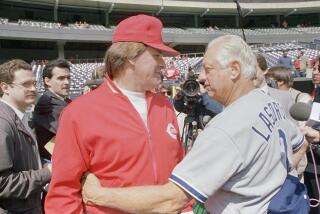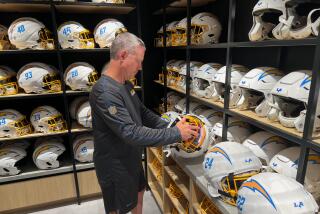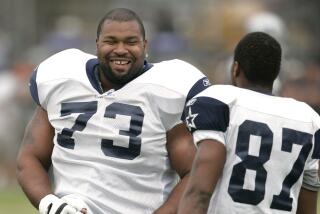Tex Schramm, 83; Turned Dallas Cowboys Into Stars
Tex Schramm, one of the most influential executives in National Football League history and the marketing visionary who put the star on the Dallas Cowboy helmet and transformed the franchise into “America’s Team,” died Tuesday at his Dallas home. He was 83.
The cause of his death was not immediately known, although Schramm had been in failing health since the death of his wife, Marty, in December. He had recently been under hospice care.
For the record:
12:00 a.m. July 19, 2003 For The Record
Los Angeles Times Saturday July 19, 2003 Home Edition Main News Part A Page 2 National Desk 1 inches; 49 words Type of Material: Correction
Tex Schramm obituary -- An obituary in Wednesday’s California section incorrectly stated that Tex Schramm had served in the U.S. Air Force during World War II. Schramm was in the U.S. Army Air Forces. The Air Force was created as a separate arm of the armed services in 1947.
As president of the Cowboys and the team’s guiding force for 29 seasons, Schramm focused much of his attention on catering to the paying customer.
He is credited with developing the largest radio network of any sports franchise -- more than 200 stations -- and was perhaps the first in professional football to institute Spanish-language broadcasts. He put the game time on the scoreboard clock, and the Dallas Cowboys cheerleaders, the first of their kind in pro sports, on the sidelines.
“Mr. Schramm was Barnum and Bailey all rolled into one,” former Cowboy player Charlie Waters said. “He was a great salesman.”
A onetime $30-a-week sportswriter who was born in Los Angeles and grew up in the San Gabriel Valley, Schramm was named Texas after his father. After graduating from the University of Texas and serving in the Air Force during World War II, Schramm began his football career as publicity director for the Los Angeles Rams. He worked his way up to general manager and gave Pete Rozelle his first job in football, hiring the eventual NFL commissioner to replace him as publicity director.
As president and general manager of the Cowboys from 1960 through 1989, Schramm hired Tom Landry as coach and personally drafted such leading players as Roger Staubach, Bob Hayes, Tony Dorsett and Herschel Walker. Under Schramm’s watch, the Cowboys had 20 consecutive winning seasons and appeared in five Super Bowls, winning two.
But his realm of influence extended well beyond the Cowboys.
He played a significant role in the 1966 merger between the NFL and the American Football League, meeting with Kansas City Chief owner Lamar Hunt to meld the rival leagues and create the championship game that would become the Super Bowl.
He was chairman of the league’s Competition Committee from 1966 through 1988. He promoted the wild-card playoff system that is still in use. As head of the inaugural competition committee, he led a group composed of NFL legends Vince Lombardi, Paul Brown and Al Davis. Like those three, Schramm is a member of the Pro Football Hall of Fame.
In 1970, a year before the Cowboys won their first Super Bowl, Schramm helped negotiate the collective bargaining agreement between the NFL and the Players Assn. When NFL players went on strike in 1987, Schramm came up with the idea of hiring replacement players. There has been no player work stoppage in the NFL since the 1987 strike.
“He was a competitor and loved to argue, but he had a lot of class and you always knew he was trying to do what was best for the NFL,” Gene Upshaw, executive director of the NFL Players Assn., said in a prepared statement Tuesday. “He played a big part in getting us to where we are today.”
In a statement Tuesday, Rozell’s successor, NFL Commissioner Paul Tagliabue, reflected on Schramm’s legacy.
“He played a major role in building the NFL into America’s passion by developing a glamour franchise with national appeal and by his leadership on so many league issues,” Tagliabue said in a prepared statement. “As commissioner, I have benefited greatly from what Tex had a big hand in creating.”
Schramm was one of the first proponents of using instant replay to augment officiating. He advocated sudden death overtime for regular season games. He also came up with the idea of putting radio receivers in the helmets of quarterbacks, widening sideline borders, restarting the play clock immediately after a play ended, and putting wind-direction strips atop goal post uprights.
The Cowboys were the first team to wear their white uniforms at home, a decision that could have given them a strategic advantage.
“Tex wanted the home fans to see what the opponent’s colors really were, or at least that was the premise he used,” longtime Cowboy scouting director Gil Brandt said Tuesday in an article on NFL.com. “He would always deny it, but my feeling was that it was always 90 or 95 degrees on the sidelines, and it’s a lot hotter when you wear a dark blue jersey or a black jersey in that heat.”
Among the other Schramm innovations:
* Moved goal posts back from the goal line to a safer location on the end line.
* Implemented the in-the-grasp rules to protect quarterbacks from defensive players, and enabled quarterbacks to stop the clock by throwing directly into the ground.
* Further encouraged scoring with stricter pass-defense rules.
* Instituted the idea of giving a referee a microphone to announce penalties.
“He had a unique combination of the big picture and the details,” said Greg Aiello, the NFL’s vice president of public relations who spent 10 years with Schramm and the Cowboys.
The Cowboys play on Thanksgiving every year because of Schramm. The Detroit Lions were the traditional Thanksgiving team and generally held down the morning time slot on national television.
Whereas other organizations backed away from taking on the afternoon time slot, uneasy about playing on three day’s rest after the traditional Sunday games, Schramm couldn’t resist the idea that the Cowboys would be in the national spotlight every year.
“The whole nation was going to pay attention to us, whether people liked it or not,” Waters said. “It wasn’t easy at first, having such little time to prepare for a game. But after we did it one time, we knew the formula. It was fun for us. We welcomed that Thursday game.”
And although Schramm did not coin the phrase “America’s Team” -- that distinction belongs to a producer for NFL films -- he was savvy enough to understand the value of the moniker and used it freely in promoting the team.
The Cowboys also became known for their sophisticated evaluation techniques in scouting players. Schramm was among the first to bring computer analysis into the process. He also hired Brandt to scour the nation in search of college talent. Two of their best players were an example of the success of this assessment process. In 1964, the Cowboys used a seventh-round draft pick on Hayes, an Olympic gold medal sprinter they turned into an All-Pro receiver. That same draft, they used a 10th-round pick on Navy quarterback Staubach, who still had a four-year military commitment ahead of him. Staubach came out of the service and became a Super Bowl MVP.
Schramm worked for the Rams from 1947 to 1957, then spent three years as an executive at CBS in New York. There, he orchestrated the first live broadcast of the Winter Olympics. It was his idea to use a studio host, too, and he chose Walter Cronkite, years before he was the host of the CBS Evening News.
In 1960, when Dallas formed a franchise that had yet to be approved by the NFL, prominent Texas oilman Clint Murchison hired 39-year-old Schramm to run the team. Landry was one of Schramm’s first hires.
Dallas didn’t win a game its first season, and there were lots of people who thought Landry should be fired. Instead, Schramm signed him to a 10-year contract extension.
The Cowboys wound up winning division titles in 1966 and 1967, and won their first Super Bowl titles after the 1971 and 1977 seasons. Through it all, Schramm didn’t lack for confidence. “We used to say he was the only guy who could strut while he was sitting down,” Waters said.
There was no denying the Cowboys’ success with Schramm at the helm. From 1966 to 1985, they set an NFL record with 20 consecutive winning seasons, the third-longest streak in a major North American professional sport behind baseball’s New York Yankees (39) and hockey’s Montreal Canadiens (32).
When current owner Jerry Jones bought the Cowboys in 1989, the team had had three consecutive losing seasons and was struggling financially. Jones first fired Landry and then Schramm, sparking a public outcry. Relations between Schramm and Jones were cool for more than a decade, a time in which the Cowboys won three more Super Bowls. The public impasse ended three months ago when the Cowboys announced Schramm would be the 12th inductee into the team’s Ring of Honor, which encircles the field at Texas Stadium. He was to be inducted into the ring, which he himself established as part of the Cowboy franchise, at a game this fall.
“Tex is here because of the very obvious,” Jones said when the Ring of Honor announcement was made. “He will always be recognized wherever the Cowboys are, whether they are in Texas Stadium or in another arena. He is going to be recognized as the architect, as the man who started and built the Cowboys into America’s Team. That’s as it should be. If it had not been for Tex, I wouldn’t have wanted to buy the team 14 years ago. That transcends all the things that might come about on the personal nature and otherwise.”
Schramm is survived by daughters Christi Wilkinson and Kandy Court, and six grandchildren.
A memorial service will be held Friday at 2 p.m. at Lovers Lane United Methodist Church in Dallas.
More to Read
Go beyond the scoreboard
Get the latest on L.A.'s teams in the daily Sports Report newsletter.
You may occasionally receive promotional content from the Los Angeles Times.











